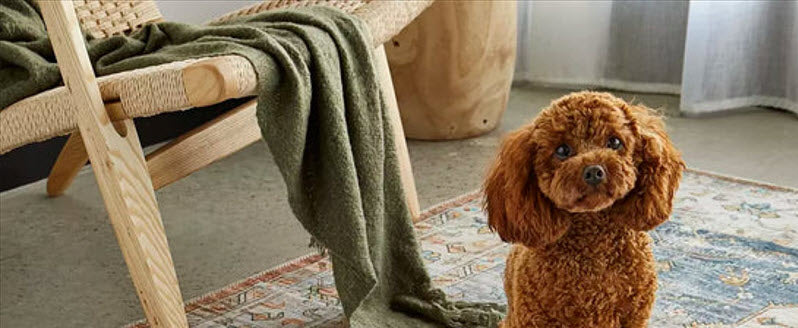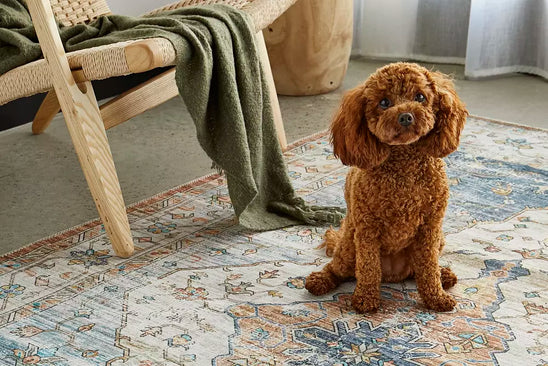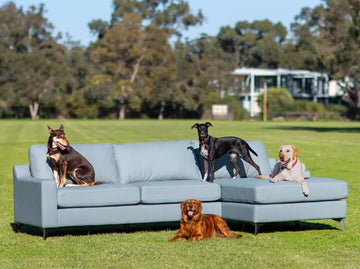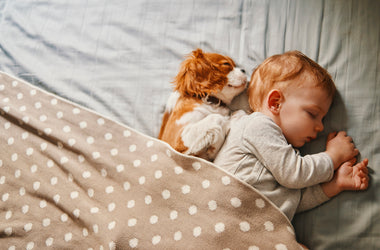Fresh styles, low prices!
Fresh styles, low prices!

If you go to relax on the couch and find dog piddle waiting for you, you're not alone in your frustration or confusion! Many people who own dogs, puppies and grown, face this issue, begging the question 'why is my dog peeing in the house all of a sudden?' It’s important to address this to maintain health, cleanliness and, of course, happiness.
Let's explore the possible reasons why your male or female dog is suddenly peeing in the house, discuss how to stop puppies and grown dogs from doing this, and introduce preventive measures to keep your home wee-free. We'll also highlight pet friendly furniture as an innovative solution for dog owners dealing with this challenge.

Understanding the root cause is the first step in addressing why your male or female dog is suddenly peeing in the house. There are four primary reasons your puppy or grown dog may be peeing on the couch or elsewhere in your home:
Uncovering the root cause is vital to keeping your furry friend from tinkling indoors and bringing relief to both of you.
Medical conditions, such as a urinary tract infection or diabetes, can make dogs suddenly pee inside. Keep an eye out for symptoms such as:
These symptoms can indicate a urinary tract infection. Age and medical issues like bladder infections, bladder stones and nerve damage can also be behind a dog’s incontinence, especially in senior dogs.
If you suspect a medical issue is causing your dog to pee inside, it's crucial to visit a vet to diagnose and treat any problems. Timely intervention can not only resolve peeing inside, but also safeguard your dog's health and keep them from suffering.
Anxiety and stress can lead to indoor peeing in dogs as well. Changes in the household, such as the addition of a new family member like a new baby or new pet, can trigger anxiety or stress in dogs. Separation anxiety is another common issue, where dogs become anxious when their beloved owners leave them home alone.
To help your dog cope with anxiety and stress, you can:
Territorial marking is a natural behaviour in dogs, especially males, to assert dominance. Dogs communicate and mark their territory through peeing. Male dogs that haven’t been neutered are more likely to mark their territory. However, female dogs can also exhibit this behaviour, albeit less frequently. Neutering or spaying can significantly prevent marking.
Incomplete house training or regression can cause dogs to start peeing on furniture and through the home. Reinforcing training with positive reinforcement, like treats and verbal praise, as well as consistency can help your dog learn where they should and shouldn’t go potty.
Crate training can be an effective technique too, teaching your dog not to urinate where they sleep. By providing a consistent routine and rewarding your dog for their progress, you can ensure a successful experience.

Having identified the possible reasons why your male or female dog is peeing in the house all of a sudden, we can now discuss ways to stop this behavioural issue. We’ll address each cause with a corresponding solution:
These solutions can help stop dogs peeing and making the problem worse.
If a medical issue is the cause of your dog peeing on furniture, you should consult a vet for diagnosis and treatment urgently. Urinary tract infections, diabetes and kidney disease are common health issues that could be causing your puppy or grown dog to have indoor accidents. Diagnostic tools like X-rays and abdominal ultrasounds can be used to diagnose bladder stones, and treatment options include dietary modifications, prescription diets and surgical procedures like lithotripsy.
Promptly addressing a medical condition with a treatment plan can solve your dog’s indoor peeing problem, as well as support their health and wellbeing.
Aiding your dog in managing their anxiety and stress can play a major role in preventing peeing on couches and floors. Providing positive reinforcement and sticking to a consistent routine can help soothe your dog’s anxiety. Engaging toys, like calming chew toys or puzzle toys, can also help distract and relax your dog while you’re away.
Desensitization training, which involves gradually exposing anxious dogs to the thing that triggers their fear or anxiety, can be an effective strategy too. Remember to stay positive, keep sessions short and reward your pup with treats to celebrate their progress.
Neutering your dog can help with territorial marking and decrease their instinct to mark. Redirecting marking behaviour outdoors can also help prevent indoor marking. Provide your dog with designated areas to mark, such as a post or tree in the yard, and reward them for marking in those areas. This will help them associate marking outdoors with positive experiences, reducing indoor marking behaviour.
Redirecting marking behaviour outdoors and getting your dog neutered can lower the odds of indoor marking, keeping your home clean and fresh.
Fortifying house training is key to avoiding indoor peeing. Use positive reinforcement techniques, such as providing treats or verbal praise, when your dog eliminates in the appropriate area. Crate time can also help your pup learn to hold their bladder for longer periods of time and reinforce good behaviour.
When you reinforce house training, you are aiding your pup’s learning. A fully house-trained dog is much less likely to have indoor accidents, helping you maintain a harmonious home environment.

Dealing with indoor peeing can be frustrating. Pet friendly furniture can be a lifesaver for dog owners facing this issue! Our pet friendly couches are:
These features make our pet friendly lounges an ideal choice for dog owners who want to protect their couch from damage caused by dog pee. Waterproof and mildew-proof furniture is particularly beneficial for pet owners, helping to protect against little accidents and making them easier to clean. Simply wipe or wash off any urine. You won't have to worry about it seeping into your cushions or upholstery, which can cause bacteria growth and unpleasant odours.

Taking preventive measures is an important part of how to keep your dog from peeing on the couch or floor. Prevent your dog from doing a pee in the wrong place through:
These measures will help most dogs who end up relieving themselves inside.
Making sure they spend enough time outdoors is critical to ensuring dogs pee outside of the home. Outdoor time provides your dog with exercise, mental stimulation and bathroom breaks. Aim to provide your dog with at least one to two hours of outdoor time every day, keeping in mind that this amount can vary depending on the dog’s age, breed and individual needs.
Establishing a regular schedule for outdoor trips and gradually increasing the time between outings can help dogs learn to hold their bladder for longer periods. Another plus is that it allows them to socialise with other dogs.
Cleaning is essential to eliminating the smell of urine and will stop your dog from marking its territory inside (a dog's nose is highly sensitive). Enzymatic cleaners are specially formulated to break down the molecules of urine and effectively remove the smell from fabric like carpets and couches. Proper cleaning techniques not only help maintain a clean and fresh home, but also contribute to preventing the issue of indoor weeing.
Keeping an eye on changes in your dog’s behaviour is essential to identifying stress, anxiety and health issues that can cause many dogs to pee indoors. Be mindful of behaviour changes like destructive behaviour, signs of discomfort or excessive licking of the urinary opening, which can indicate stress, anxiety and a urinary tract infection.
Promptly addressing these issues can prevent your dog from peeing on the couch and floor, as well as promote their wellbeing. Regular vet check-ups and maintaining a close bond with your dog can also help you stay aware of any changes in their behaviour over time.
As a dog owner, finding your furry friend peeing in the house or on the couch all of a sudden isn't a nice feeling. You may get tired of cleaning up or worried about your dog suffering. By understanding why your male or female dog is suddenly peeing in the house, you can stop the issue from happening and prevent it in the future. For added protection, you can get one of our pet friendly couches that are perfect for both puppies and grown dogs! Now you can rest assured your house stays clean and your dog is happy and healthy.
It's hard to give an exact cause as male dogs can start peeing in the house for various reasons. These include hormonal influences, a new dog entering their territory, moving house, getting new furniture or stress and anxiety. Urine marking is also common among males. Urinary tract infections, cystitis, bladder stones, kidney disease, arthritis and incontinence issues can all be reasons why your dog pees inside too.
As with male dogs, female dogs may suddenly pee in the house for a number of reasons. Urinary tract infections, behavioural issues, age-related incontinence and changes in her environment are just some examples. It's always important to consult a vet who can rule out health issues and help you understand what is happening.
To stop your grown dog from tinkling in the house, you could start by establishing a consistent bathroom schedule, rewarding outdoor elimination and limiting indoor access until the habit improves. Not forgetting to clean soiled areas thoroughly. However, it is always recommended to consult a vet so you can rule out medical issues. You may also want to consider professional behavioural training.
Puppies need to be taken outside for bathroom breaks regularly, especially after meals and naps. Reward them for going outside. When they do have an accident, use an enzymatic cleaner to remove the scent. You may want to consider puppy pads. You should also limit couch access until they're reliably house trained. Consistency and positive reinforcement are key!